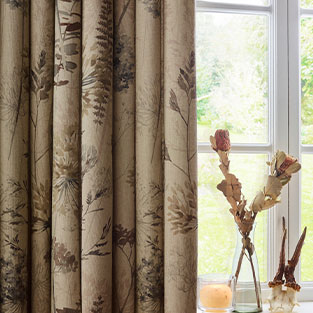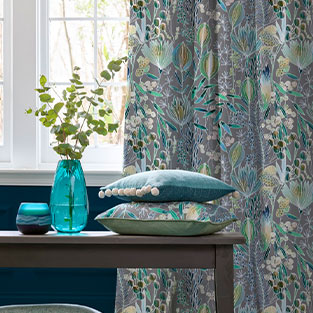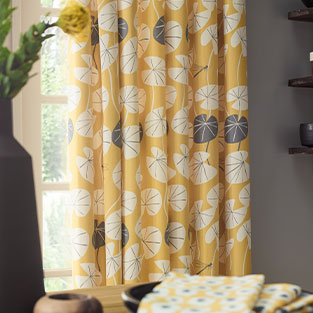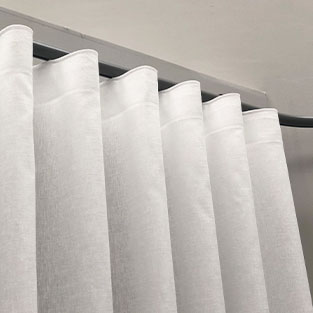What is Curtain Lining?
Curtain Lining is the fabric which sits behind the face fabric when making curtains. Maybe you are wanting fuller looking curtains, to add shape, or wanting to block out the sunlight, there is a lining to solve these problems. Linings come in a range of functions, read on to find out the best lining fabrics for curtains.
Lining is most commonly plain but can be patterned or striped depending on your scheme and look you are wanting to achieve. Typically, lining fabrics are made from cotton because it helps the curtain drape well and gives the curtains a luxurious feel.

Plain Cotton Curtain Lining Fabric
Plain cotton lining fabric is 100% cotton and typically has a sateen weave. Plain linings can come in neutral colours like white, cream or ivory, or you can opt for a colour like red, blue or silver if you are wanting to add colour also from the back of the curtains. You can also have a striped lining which gives the curtains more personality and often a preferred choice when you can see both sides of the curtains on a door.
Plain cotton linings have no added extra special qualities compared to other linings, but they are solely used to enhance and give the face fabric a backing, help to make the curtains drape nicely and also to protect the curtain fabric from direct sunlight.

Blackout Curtain Lining Fabric
Blackout lining is a specialised lining fabric which will block out the light from your window. Typically used in bedrooms, black out lining is great if you wanted to block out light in a room when the curtains are drawn. Using blackout lining will also help block the curtains from direct sunlight and therefore stopping fading and protecting the curtain fabric.
Blackout lining will also keep your room cool as it reduces the amount of light dispersing into a room which is why it’s a fantastic choice for a bedroom. Blackout lining generally comes in two colours, white or natural but more recently you can find coloured black out linings. We stock Grey, Stone and Black.

Thermal Curtain Lining Fabric
Thermal curtain lining is a specialised lining which will not only keep your room warm and cosy throughout those colder months, but it will also keep hot air out by reflecting it outside in the warmer months.
Thermal curtain lining fabrics have many beneficial properties such as retaining heat, improving comfort in a room, reducing energy consumption and also reducing noise pollution. Perfect for a window or door which has a draft, thermal lining is a fraction thicker than cotton lining and will give the curtains a beautiful drape.

Curtain Interlining Fabric
Interlined curtains have three layers, firstly you have your main fabric, then an interlining layer and then a plain cotton lining. The interlining is sandwiched between the face fabric and plain lining providing extra warmth and body to your curtains. The reason you would choose interlining over a thermal lining is because you either have a considerably cold house or you want the curtains to have a fuller look. Depending on the heading style chosen, interlined curtains will hang beautifully and help keep their shape. Interlining comes in two compositions, Cotton or Acrylic. The cotton is much thicker and higher quality to an acrylic interlining which is thinner and not as durable over a long period of time.
If you were wanting something in between these weights you could opt for a Nap lining. Nap lining is a brushed cotton which acts as a cheat lining because it has plain lining one side and interlining the other, creating a 2 in 1 effect. Nap lining is an excellent choice for beginner curtain makers because it’s less work when sewing but will still give the curtains body and keep the room cosy.

Do All Curtains Need Lining?
Not all curtains will need to be lined and it is always personal preference whether you chose to line your curtains or not. If you are not needing a specific function for your curtains, then you don’t have to line your curtains, it’s just what we would recommend for durability and aesthetic purposes. Fabrics like sheers and voiles are commonly used for privacy instead of a functioning curtain. Sheers and Voiles can also be used for dress curtains which help frame a window instead of being used. These types of fabrics are often thin, so you wouldn’t want a lining showing through.
Blackout fabrics such as Ascot FR is a plain fire-retardant fabric which is a great choice for curtains because you would not need to line the fabric. This is a practical choice for hotels, schools and of course, curtains in your home. This plain fabric has already been treated to crib 5 standard and could be a more affordable option for curtains if needing to make a large quantity.






